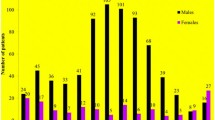Abstract
Within the metal/nonmetal mining sector, fall-related incidents account for a large proportion of fatal and non-fatal injuries. However, the events and contributing factors leading up to these incidents have not been fully investigated. To help provide a clearer picture of these factors, an analysis of imminent danger orders issued by the Mine Safety and Health Administration (MSHA) between 2010 and 2017 at both surface and underground metal/nonmetal mine sites revealed that most orders are associated with fall risks. Of these cases, 84% involved the workers not using fall protection, fall protection not being provided, or the improper use of fall protection. Fall risks for workers most frequently occurred when standing on mobile equipment, performing maintenance and repairs on plant equipment, or working near highwalls. In most cases, a single, basic, corrective action (e.g., using fall protection) would have allowed workers to perform the task safely. Overall, these findings suggest that a systematic approach is needed to identify, eliminate, and prevent imminent danger situations. Furthermore, to protect mineworkers from falls from height, frequently performed tasks requiring fall protection should be redesigned to eliminate the reliance on personal fall protection.


Similar content being viewed by others
References
Scharf T, Vaught C, Kidd P, Steiner L, Kowalski K, Wiehagen B et al (2001) Toward a typology of dynamic and hazardous work environments. Hum Ecol Risk Assess Int J 7(7):1827–1841. https://doi.org/10.1080/20018091095429
Feyer AM, Williamson AM, Stout N, Driscoll T, Usher H, Langley JD (2001) Comparison of work related fatal injuries in the United States, Australia, and New Zealand: method and overall findings. Inj Prev 7(1):22–28
MSHA (2015). Mining industry accident, injuries, employment, and production statistics and reports. https://www.cdc.gov/niosh/mining/data/default.html
Nasarwanji MF (2016a) Causes of fall fatalities at surface mines. Retrieved from http://me.smenet.org/docs/Publications/ME/Issue/DecWebOnly16/index.html?pageIndex=1
30 CFR Part 50 – Notification, Investigation, Reports, and Records of Accidents, Injuries, Illnesses, Employment, and Coal Production in Mines. (n.d.). Retrieved from https://www.law.cornell.edu/cfr/text/30/part-50
MSHA (1977) Federal Mine Safety & Health act of 1977. Mine Safety and Health Administration. https://arlweb.msha.gov/REGS/act/mineact77.pdf
Drury CG, Porter WL, Dempsey PG (2012) Patterns in mining haul truck accidents. Proceedings of the Human Factors and Ergonomics Society 56th Annual Meeting, Santa Monica: Human Factors and Ergonomics Society, 2011-2015
MSHA (2018) 107(a) Orders. Mine Safety and Health Administration. https://arlweb.msha.gov/OpenGovernmentData/107a/107aOrders.asp
U.S. DOL (2011). United States Department of Labor, Mine Safety and Health Administration, MSHA Handbook Series: Accident/Illness Investigations Procedures, Handbook Number: PH11-I-1, June 2011
Eiter B, Hrica J, Willmer D (2018) Imminent danger: characterizing uncertainty in critically hazardous mining situations. Min Eng 70(9):47–52. https://doi.org/10.19150/me.8490
Nasarwanji MF (2016b) Contributing factors to slip, trip, and fall fatalities at surface coal and metal/nonmetal mines. Proc Hum Factors Ergon Soc Annu Meet 60(1):1666–1670. https://doi.org/10.1177/1541931213601384
Eiter B, Kosmoski C, Connor B (2016) Defining hazard from the mine worker’s perspective. Min Eng 68(11):50–54. https://doi.org/10.19150/me.6832
Willmer DR (2017) Exploring the use of situation awareness in behaviors and practices of health and safety leaders. Trans Soc Min Metall Explor 342(1):36–42. https://doi.org/10.19150/trans.8106
Nelson NA, Kaufman J, Kalat J, Silverstein B (1997) Falls in construction: injury rates for OSHA-inspected employers before and after citation for violating the Washington state fall protection standard. Am J Ind Med 31(3):296–302. https://doi.org/10.1002/(sici)1097-0274(199703)31:33.3.co;2-q
Muzaffar S, Cummings K, Hobbs G, Allison P, Kreiss K (2013) Factors associated with fatal mining injuries among contractors and operators. J Occup Environ Med 55(11):1337–1344. https://doi.org/10.1097/jom.0b013e3182a2a5a2
Lenné MG, Salmon PM, Liu CC, Trotter M (2012) A systems approach to accident causation in mining: an application of the HFACS method. Accid Anal Prev 48:111–117. https://doi.org/10.1016/j.aap.2011.05.026
Radomsky M, Ramani RV, Flick JP (2001) Slips, trips & falls in construction & mining: causes & controls. Prof Saf 46(9):30
Nadhim EA, Hon C, Xia B, Stewart I, Fang D (2016) Falls from height in the construction industry: a critical review of the scientific literature. Int J Environ Res Public Health 13(7):638. https://doi.org/10.3390/ijerph13070638
Cattledge GH, Schneiderman A, Stanevich R, Hendricks S, Greenwood J (1996) Nonfatal occupational fall injuries in the West Virginia construction industry. Accid Anal Prev 28(5):655–663. https://doi.org/10.1016/0001-4575(96)00026-7
Chandler MD, Bunn TL, Slavova S (2017) Narrative and quantitative analyses of workers’ compensation-covered injuries in short-haul vs. long-haul trucking. Int J Inj Control Saf Promot 24(1):120–130. https://doi.org/10.1080/17457300.2016.1170041
Author information
Authors and Affiliations
Corresponding author
Ethics declarations
Disclaimer
The findings and conclusions in this report are those of the authors and do not necessarily represent the official position of the National Institute for Occupational Safety and Health, Centers for Disease Control and Prevention.
Conflict of Interest
The authors declare that they have no conflict of interest.
Additional information
Publisher’s Note
Springer Nature remains neutral with regard to jurisdictional claims in published maps and institutional affiliations.
Rights and permissions
About this article
Cite this article
Hrica, J.K., Eiter, B.M., Pollard, J.P. et al. Analysis of Fall-Related Imminent Danger Orders in the Metal/Nonmetal Mining Sector. Mining, Metallurgy & Exploration 37, 619–630 (2020). https://doi.org/10.1007/s42461-020-00186-w
Received:
Accepted:
Published:
Issue Date:
DOI: https://doi.org/10.1007/s42461-020-00186-w




